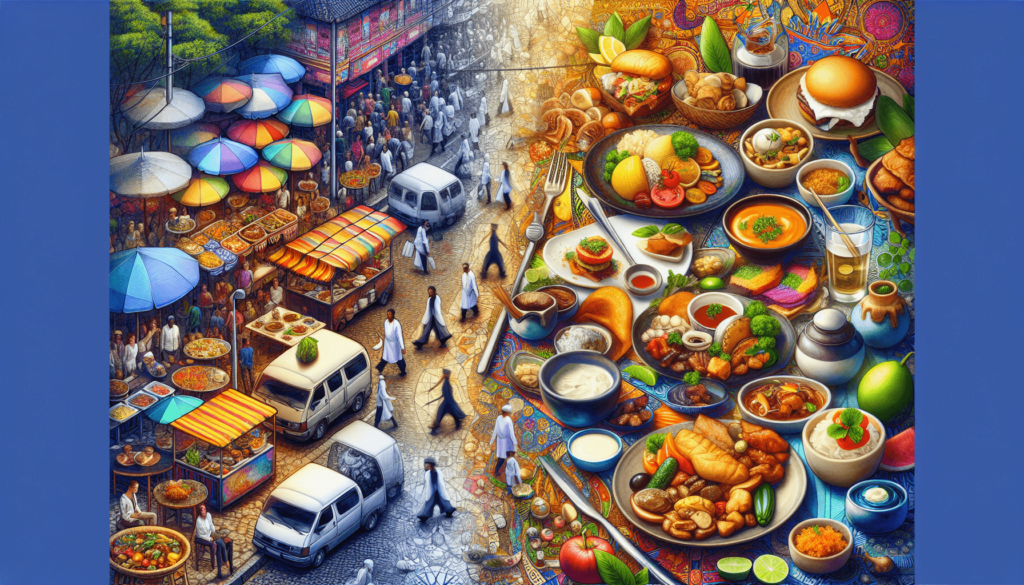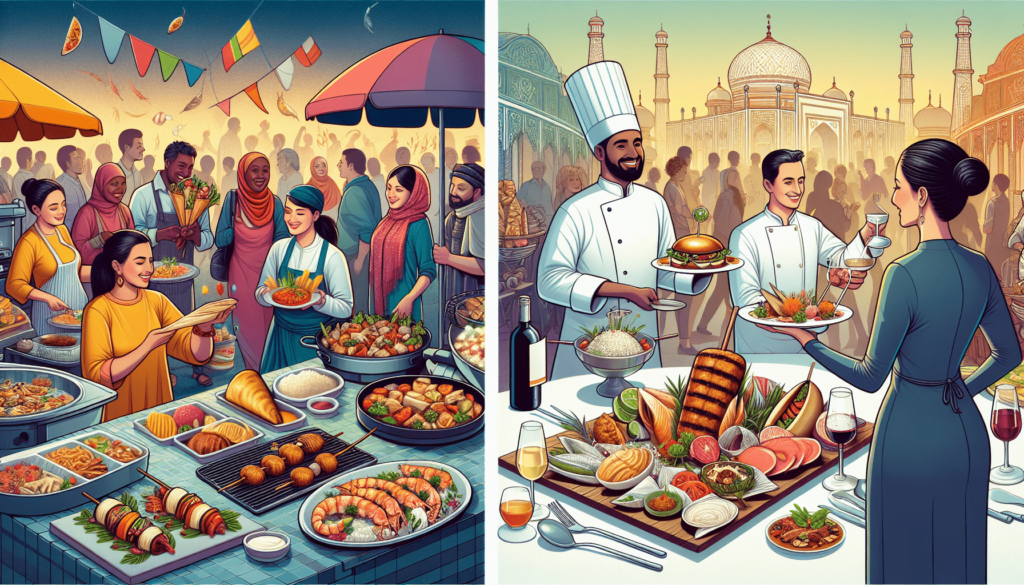In “Exploring the Diversity of Global Gastronomy: From Street Food to Fine Dining,” you’ll embark on a flavorful journey through the varied landscapes of world cuisine. The article deftly blends historical and contemporary perspectives, painting a vivid picture of how culinary practices have evolved from humble street vendors to exquisite fine dining establishments.
You’ll uncover the rich tapestry of global gastronomy, understand key concepts, and see compelling examples that illustrate the interplay between tradition and innovation. From the bustling food stalls of Bangkok to the opulent Michelin-starred restaurants of Paris, the piece highlights how food not only sustains but also connects cultures. Future trends and implications provide a glimpse into what lies ahead in the culinary world, making this a must-read for any food enthusiast.
Table of Contents
Exploring the Diversity of Global Gastronomy: From Street Food to Fine Dining
Have you ever wondered how the flavors of the world intertwine to create a rich tapestry of culinary traditions?
The sheer diversity of global gastronomy offers us a window into the culture, history, and ingenuity of different societies. From vibrant street food markets teeming with tantalizing aromas to the sophisticated ambiance of fine dining establishments, the culinary landscape is as broad as it is delicious. Together, let’s journey through this vibrant world of flavors, discovering what makes each bite a reflection of its origin.
Overview
Food is much more than sustenance; it’s a way to experience culture, history, and innovation. Whether you’re savoring a simple street snack or indulging in an elaborate gourmet meal, every bite carries a story. This exploration will reveal the fascinating spectrum of global gastronomy, touching upon its roots, current trends, and future directions.
Thesis Statement
This article aims to illuminate the vast diversity of global culinary experiences, from the humble street food stalls to the sophisticated fine dining restaurants, demonstrating how each contributes uniquely to our understanding and appreciation of food.
Historical Context
Food has always been a central part of human history. From ancient feasts to modern fusion cuisine, the way we eat has evolved significantly over millennia. The history of international cuisine is a mosaic of migrations, trades, and cultural exchanges, each contributing distinct flavors and techniques to the world’s culinary map.
Ancient Times to Medieval Period
In ancient times, the Silk Road played an essential role in the exchange of spices, fruits, and cooking techniques between Asia, the Middle East, and Europe. This period saw the introduction of exotic flavors that were previously unknown to many civilizations. Similarly, the Age of Discovery led to the global exchange of foods like tomatoes from the Americas to Europe and spices from Asia to the Western world.
The Industrial Revolution
The Industrial Revolution brought significant changes to food production and distribution. Mass production and transportation innovations made a variety of foods accessible to more people, laying the groundwork for today’s global culinary landscape.
The Modern Era
In the modern era, globalization has led to a blending and appreciation of diverse culinary traditions. Fusion cuisine, incorporating elements from multiple cultures, has become a hallmark of contemporary fine dining, while street food has gained recognition as an authentic and vibrant culinary experience.
Current Trends
Today, the culinary world is more interconnected than ever. Trends reflect a growing appreciation for diversity, sustainability, and innovation.
Farm-to-Table Movement
One prominent trend is the farm-to-table movement, which emphasizes sourcing ingredients locally and sustainably. This approach supports local agriculture and promotes environmental responsibility. Fine dining establishments and even some street food vendors highlight the provenance of their ingredients, ensuring freshness and ethical sourcing.
Culinary Tourism
Culinary tourism is another rising trend, with travelers seeking authentic food experiences as a central part of their journeys. From exploring night markets in Taipei to dining at Michelin-starred restaurants in Paris, the desire to experience food in its cultural context has expanded the scope of travel experiences.
Technology and Food
Technology has also made its mark on the culinary world. Innovations like food delivery apps, virtual cooking classes, and kitchen gadgets have changed how we prepare and consume food. Additionally, social media platforms have become essential for discovering new trends and sharing culinary experiences.
Key Concepts and Definitions
Understanding certain terms and concepts can help fully appreciate the global gastronomy landscape.
Gastronomy
Gastronomy refers to the art and science of food, encompassing cooking techniques, food preparation, and the study of different cultural food traditions.
Street Food vs. Fine Dining
Street food is typically affordable, quick, and reflects local culinary traditions. In contrast, fine dining offers a more elaborate experience with meticulously prepared dishes and high-quality ingredients, often served in a sophisticated setting.
Farm-to-Table
This concept focuses on sourcing food directly from local farms, emphasizing freshness, seasonality, and sustainability.

This image is property of images.pexels.com.
Detailed Exploration
Let’s dive deeper into the different aspects of global gastronomy, exploring street food and fine dining in various regions around the world.
Street Food
Street food embodies the essence of a nation’s culinary tradition. It’s accessible, authentic, and bursting with flavor. Each region has its unique specialties, reflecting both the ingredients and the spirit of the community.
Asia
Asia is renowned for its vibrant street food culture. From the bustling markets of Bangkok to the food carts of Tokyo, street vendors serve dishes that are both delicious and affordable.
- Thailand: Pad Thai and Mango Sticky Rice
- Japan: Takoyaki and Yakitori
- India: Pani Puri and Vada Pav
The Americas
Street food in the Americas is an eclectic mix of indigenous ingredients and immigrant influences.
- Mexico: Tacos and Elote
- USA: Hot Dogs and Pretzels
- Brazil: Acarajé and Coxinha
Europe
While street food may not be the first thing that comes to mind when thinking of Europe, the street food scene here is growing and diversifying.
- Italy: Arancini and Gelato
- Germany: Currywurst and Pretzels
- Turkey: Simit and Döner Kebab
Africa
African street food is rich and varied, reflecting the continent’s diverse cultures and geographies.
- Nigeria: Suya and Puff-Puff
- South Africa: Bunny Chow and Braaibroodjies
- Morocco: Msemen and Brochettes
Fine Dining
Fine dining, on the other hand, offers an entirely different gastronomic experience. It focuses on haute cuisine — highly refined and meticulously prepared meals often enjoyed in a formal setting.
Europe
Europe has long been the center of culinary innovation and sophistication.
- France: Gourmet Techniques and Michelin Stars
- Italy: Rich Tradition and Modern Interpretations
- Spain: Innovative Five-Star Tapas
North America
Fine dining in North America blends multicultural influences and cutting-edge culinary techniques.
- New York City: Fusion and Modern American Cuisine
- San Francisco: Farm-to-Table and Sustainability
- Mexico: High-End Traditional Food
Asia
Asia’s fine dining scene has rapidly evolved, blending tradition with modernity.
- Japan: Kaiseki and Sushi
- Singapore: Fusion Cuisine and Michelin-Starred Hawker Stalls
- China: Peking Duck and Fine Tea
Middle East and Africa
Fine dining in the Middle East and Africa represents a blend of traditional flavors and contemporary techniques.
- UAE: Luxurious Experiences and International Influences
- South Africa: Indigenous Ingredients and Wine Pairings
- Morocco: Tagines and Moroccan-Spiced Dishes
Example 1: Street Food Case Study – Thailand
Thailand’s street food scene is legendary. Not only is it delicious, but it’s also incredibly diverse. Take, for example, the ever-popular Pad Thai. This dish originated from a period of economic hardship in Thailand when the government promoted rice noodles to lower rice consumption. Today, Pad Thai is a global favorite.
Why it Matters
- Economic Impact: Street food vendors play a crucial role in Thailand’s economy, providing affordable food and employment.
- Cultural Significance: Street food offers a taste of authentic Thai cuisine, preserving traditional recipes and cooking methods.

This image is property of images.pexels.com.
Example 2: Fine Dining Case Study – France
France is synonymous with fine dining. Consider Le Bernardin in Paris, a 3-Michelin-starred restaurant known for its seafood. Established in 1972, it continues to set standards for quality and innovation in haute cuisine.
Why it Matters
- Global Influence: French culinary techniques are foundational to Western cuisine.
- Cultural Heritage: French gastronomy is recognized by UNESCO as an intangible cultural heritage, highlighting its significance.
Comparison of Different Perspectives
When considering street food and fine dining, one isn’t necessarily better than the other. Instead, each offers unique experiences and brings different elements to the table.
Street Food
- Pros: Affordability, accessibility, authenticity, variety
- Cons: Less consistency in quality, potential hygiene issues
Fine Dining
- Pros: High quality, luxurious experience, refined techniques, reliable service
- Cons: Expensive, sometimes less accessible

Impact Assessment
The impact of street food and fine dining extends beyond just the culinary world. They both influence tourism, cultural heritage, and the economy in unique ways.
Tourism
Street food attracts culinary tourists seeking authentic experiences, while fine dining draws those in search of luxury and refinement.
Cultural Heritage
Street food helps preserve local traditions and recipes, contributing to cultural continuity. Fine dining often leads to the innovation of these traditional recipes, keeping the culinary arts dynamic.
Economy
Street food provides affordable employment opportunities, whereas fine dining often supports local industries and higher-end employment.
Future Directions and Implications
As we look to the future, the trajectories of street food and fine dining reveal fascinating possibilities.
Predictions
- Sustainability: Both street food vendors and fine dining establishments will increasingly adopt sustainable practices.
- Technological Integration: Advanced kitchen technologies and online platforms will further revolutionize how food is prepared and enjoyed.
- Fusion and Innovation: Expect more fusion cuisine as culinary arts continue to blend global influences.
Implications
The evolving landscapes of street food and fine dining will have significant implications for the culinary world, impacting everything from food production methods to dining experiences.
- For Society: Increased awareness of sustainability could lead to more responsible consumer behavior.
- For the Industry: Continued innovation will drive culinary art forward, creating new dining experiences.
- For Culture: A renewed focus on authenticity and tradition through street food could preserve cultural heritage.

Conclusion
Recap
In exploring the diversity of global gastronomy, we’ve journeyed through the vibrant street food stalls and sophisticated fine dining establishments. From Pad Thai in the streets of Bangkok to a gourmet meal in a Parisian restaurant, every dish tells a story of its origin, reflecting culinary traditions and innovations.
Final Thought
Next time you take a bite of your favorite dish, remember the cultural journey it has taken to reach your plate. Whether it’s a humble street snack or a luxurious fine dining dish, each flavor carries a piece of the world’s rich culinary tapestry.
Engagement
What’s your favorite culinary experience? Share your thoughts, comment below, or reach out on social media. Let’s continue exploring the amazing world of food together!
Credible Sources:
- “The Oxford Companion to Food” by Alan Davidson
- “On Food and Cooking: The Science and Lore of the Kitchen” by Harold McGee
- “Street Food Around the World: An Encyclopedia of Food and Culture” by Bruce Kraig and Colleen Taylor Sen
- Websites like Food & Wine, Eater, and Bon Appétit for up-to-date trends and expert opinions on global cuisine.
Related site – Street Food and Fine Dining – the Culinary Intersection
